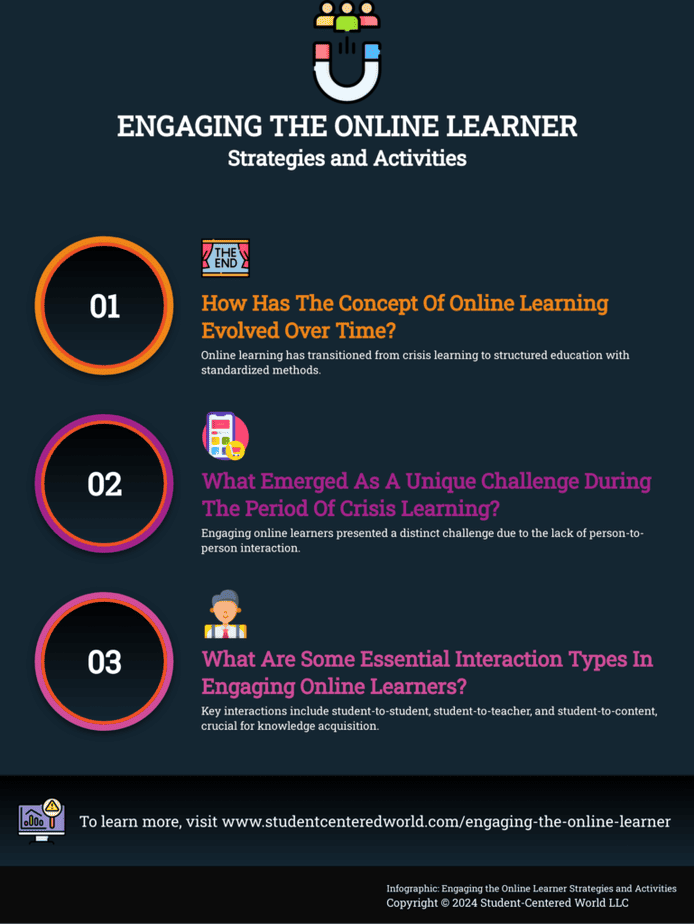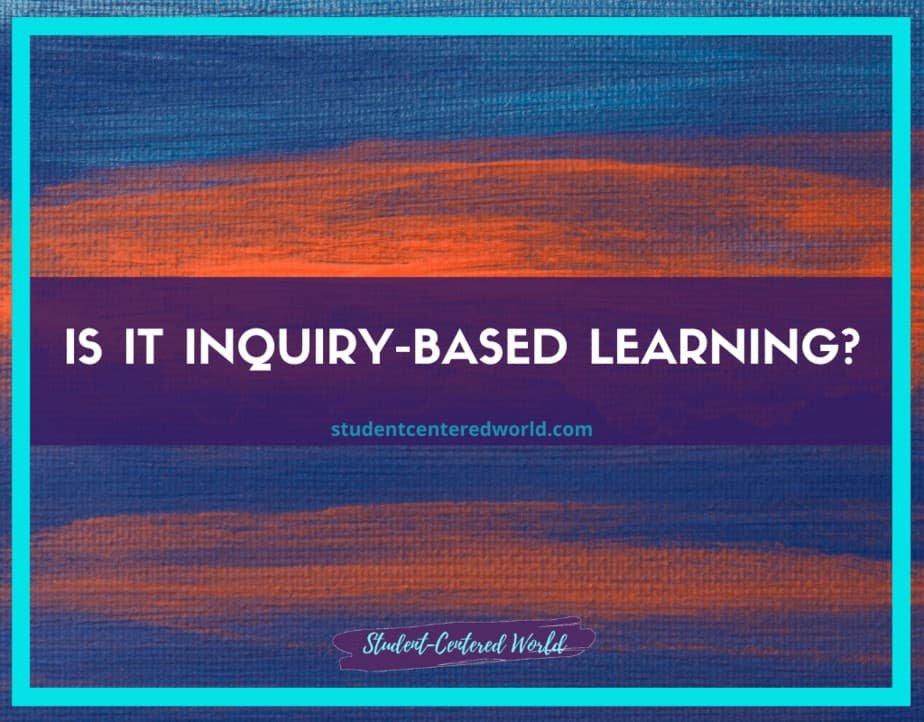Strategies and Activites for Engaging the Online Learner
Though the concept of online learning has been around for quite some time now, most families were not even aware of it until they were thrust into a virtual classroom in March 2020. The approach to instruction employed here could be classified more as “crisis learning” rather than genuine online education. Authentic online courses typically adhere to a structured curriculum, standardized instructional methods, and other established practices.
Nonetheless, one undeniable truth emerged during this period of crisis learning and still holds true today: engaging the online learner presents a unique challenge distinct from traditional classroom settings.
First and foremost, it’s essential to acknowledge that while engaging online learners differs from engaging in-person students, it is indeed achievable. Below, we’ll explore some best practices for fostering engagement in online courses. However, it’s worth noting that engaging online learners poses greater difficulty compared to both in-person classroom settings and non-virtual educational contexts.

Interaction Dynamics: Comparing Live and Online Environments
A fundamental contrast between engaging online learners and engaging those in a physical classroom lies in the level of interaction. Online learners often experience a lack of person-to-person interaction, which can be deeply frustrating. In traditional classroom settings, interaction takes various forms—student-to-student, student-to-teacher, and student-to-content—each contributing to knowledge acquisition. Although there exist multiple other interaction types and engagement sources, these three remain pivotal in classroom dynamics.
Student-to-student interaction fosters learning through peer-to-peer exchange, enabling discussions and knowledge sharing. Student-to-teacher interaction facilitates feedback and reassurance, alleviating student concerns and promoting a supportive learning environment. Lastly, student-to-content interaction provides hands-on learning opportunities, enhancing comprehension through active engagement with course materials.

While all these interaction types can occur in an online setting, they demand greater emphasis and encouragement compared to physical classrooms. For instance, involving parents in their child’s learning journey is crucial for engaging online learners, although such interactions may be less frequent than in traditional settings.
One effective strategy to encourage parental involvement is to establish a shared Google calendar, prompting parents to review their child’s activities post-lesson. This fosters engagement by keeping parents informed about their child’s learning progress and enables hands-on involvement in real-world applications.
Another distinction between engaging online learners and their in-person counterparts is the flexibility afforded to the former, particularly in terms of reviewing course materials at their own pace. While this flexibility enhances learning opportunities, it can also lead to frustration as students may need to pause their engagement in one activity to revisit previous lessons or assignments.
Despite this drawback, allowing online learners to review materials at their convenience promotes deeper learning and minimizes frustration, thereby enhancing engagement.

Challenges in Addressing Student Queries
Responding to student inquiries presents another significant disparity between online and in-person learning environments. In traditional classrooms, students frequently pose questions during lectures, fostering discussion and enriching the learning experience. In contrast, online learning necessitates a more relaxed approach to querying, encouraging both students and instructors to freely seek clarification or assistance.
However, online learners may encounter delays in receiving feedback due to the asynchronous nature of virtual interactions. Despite this, open discussions facilitated by online learning platforms enable honest exchanges between teachers and students, enhancing mutual understanding and knowledge acquisition.
While live chats and polling software offer solutions to bridge this communication gap, their implementation requires proactive planning and continuous monitoring, particularly in fully digital or hybrid class settings.
Overcoming the Human Interaction Barrier
The absence of direct human interaction poses a significant challenge in engaging online learners. Despite this, various strategies can facilitate comprehension and interaction, ensuring effective knowledge transmission in virtual settings.
Utilizing social media platforms or interactive programs like Khan Academy can foster student engagement through peer interaction or review of previously covered materials. It’s crucial to design assessments that actively engage students, thereby promoting the application of learned concepts in real-world scenarios.
Online learning systems offer diverse tools for assessing and engaging students, whether through virtual or real-time content. By providing a sense of achievement and enabling personalized learning experiences, these platforms enhance student engagement and facilitate self-paced learning.
An innovative framework for engagement encompasses a blend of real-time interactions, virtual environments, and collaborative tools like discussion forums. By tailoring engagement strategies to suit the online learning environment, educators can foster active participation and optimize learning outcomes.
The success of Online Learning
Ultimately, an effective online learning experience hinges on active engagement from all stakeholders—the learner, educator, and course facilitators. By embracing innovative teaching methodologies and leveraging technology-driven engagement tools, educators can create dynamic online courses that empower students to thrive in today’s digital learning landscape which has evolved significantly, paving the way for innovative teaching methodologies and enhanced engagement strategies.
While the journey towards effective online teaching has come a long way, there remains a pressing need for continuous adaptation and improvement. Online instructors, like J. Ana Donaldson, alongside co-facilitators of a course, play a pivotal role in navigating the complexities of virtual learning environments and maximizing student engagement across various phases of instruction.
By implementing specific ideas such as interactive online lectures, and collaborative group projects, and leveraging technology as knowledge generators, educators can create dynamic online courses that foster meaningful learning experiences. As we continue to explore new horizons in online education, it’s imperative to embrace emerging trends, refine engagement techniques, and prioritize student success in the ever-evolving landscape of online teaching and learning.

Given this, here are three quick ways to start engaging those apathetic students:
- Interactive Polls and Quizzes: Incorporate interactive polls and quizzes throughout the online lectures or course materials. This not only breaks up the monotony of passive learning but also provides immediate feedback to the learner, fostering a sense of accomplishment and progression. Utilize platforms like Kahoot! or Poll Everywhere to make the experience engaging and interactive.
- Virtual Study Groups: Encourage the formation of virtual study groups among students to facilitate peer-to-peer interaction and collaborative learning. This provides an opportunity for disengaged learners to connect with their peers, share insights, and support each other in understanding course materials. Online discussion forums or dedicated chat groups can serve as platforms for organizing these study sessions.
- Personalized Feedback and Recognition: Provide personalized feedback and recognition to acknowledge the efforts and achievements of disengaged learners. Whether through individualized emails, virtual office hours, or personalized comments on assignments, showing genuine interest in the learner’s progress can reignite their motivation and sense of belonging in the online learning community. Additionally, publicly recognizing outstanding contributions or improvements during online lectures or group discussions can serve as positive reinforcement for disengaged learners.
Stop Driving the Teacher Struggle Bus
Are you struggling with student engagement, apathy, or keeping your class on track?
💫💫 There’s hope! 💫💫
Join my free teacher workshop “Choosing Choice” and in just 45 minutes, you’ll craft a practical plan to revitalize your teaching. Discover the magic of student choice in boosting engagement, gain quick implementation ideas, and explore strategies for year-long success.
Unlike overwhelming workshops, my approach guides you in real-time, providing more classroom options, reducing stress, and giving you more personal time.
Plus, you’ll earn a 45-minute professional development certificate and have 7 days of access.
Don’t miss this chance to transform your teaching; click below to secure your spot now!
This article was originally published on July 23, 2021







